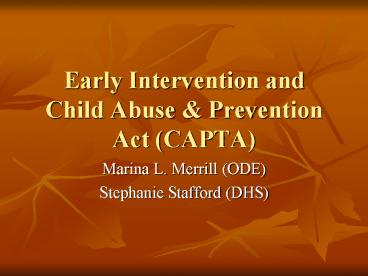Early Intervention and Child Abuse - PowerPoint PPT Presentation
1 / 11
Title:
Early Intervention and Child Abuse
Description:
Each Local Child Welfare office and county Early Intervention (EI/ECSE) program ... Minimally, each child must receive a valid and reliable developmental screening ... – PowerPoint PPT presentation
Number of Views:90
Avg rating:3.0/5.0
Title: Early Intervention and Child Abuse
1
Early Intervention and Child Abuse Prevention
Act (CAPTA)
- Marina L. Merrill (ODE)
- Stephanie Stafford (DHS)
2
CAPTA
- States receiving CAPTA funds must develop and
implement provisions and procedures for referral
of a child under the age of 3 who is involved in
a substantiated case of abuse or neglect to early
intervention services funded under part C of the
Individuals with Disabilities Education Act
106(b)(2)(A)(xxi).
3
IDEA 2004
- States must provide a description of the State
policies and procedures that require the referral
for early intervention services under Part C of a
child under the age of 3 who is involved in a
substantiated case of child abuse or neglect
637(a)(6)(A)
4
What does this mean?
- Each Local Child Welfare office and county Early
Intervention (EI/ECSE) program have an
interagency agreement that ensures that child
victims of abuse or neglect, birth to age 3, are
referred to the EI/ECSE program in the county
that the child resides.
5
Child Welfare Responsibility
- Local Child Welfare workers will refer children
under the age of 3, who are victims of child
abuse or neglect to Early Intervention services. - The standard CAPTA Referral form (CPS Early
Intervention Referral) designed for this mandate
is required. - Each Child Welfare office will use FACIS case
notes to record all children referred to the
EI/ECSE program.
6
EI/ECSEs Responsibility
- Minimally, each child must receive a valid and
reliable developmental screening to determine
eligibility for Early Intervention. - County EI/ECSE programs may use developmental
information provided by other agencies or
providers as part of the screening process to
determine need for conducting an evaluation.
7
CW EI Joint Responsibility
- Child Welfare Administrative Rule directs Child
Welfare staff to refer ALL children who fall
under this mandate to local EI/ECSE programs to
refer each child within 30 days of the founded
date.
8
Why implement links between child welfare and
Part C?
- Highest rates of abuse and neglect occur in
infants and toddlers - 16.1 per 1000 children under age 3
- High rates of developmental delay in this
population - 23-61 of children known to CW have delays in
development, communication, behavior
9
What are EI/ECSE Services?
- EI provides access to individualized
interventions at no cost to the family. - To receive services through EI, children from
birth to 3 years must meet eligibility
requirements by either having a documented
established condition, physical disability, or a
developmental delay in one or more areas. - EI performs multidisciplinary evaluation of the
child to assess cognitive, motor, social,
language, and adaptive functioning. - EI develops plan for intervention (IFSP) and
coordinates services to address child's needs.
10
EI Eligibility
- Children ages birth through two years of age with
Significant Delays in one or more of the
following domains - Cognition
- Communication
- Physical including hearing and vision
- Social or Emotional
- Adaptive
11
CAPTA Referral Status in Oregon
- Data Suggests Under referral
- Approximately 21.29 of potential referrals made
- For further Information on Early Intervention
Referrals visit - http//www.oregon.gov/DHS/children/committees/capt
a.shtml

